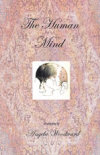The Human Mind
It would be easy to urge you to read The Human Mind because of the natural lure of the characters that people its short prose. There’s a man made of smoke and another of glass; a woman who slips her fingers into the stringy coagulation of her thoughts kept in a bowl; an impoverished Edgar Allan Poe who supports himself “on what he could squeeze out of his brain, a kind of black milk of his words.”
It would be easy to urge you to read The Human Mind because of the natural lure of the characters that people its short prose. There’s a man made of smoke and another of glass; a woman who slips her fingers into the stringy coagulation of her thoughts kept in a bowl; an impoverished Edgar Allan Poe who supports himself “on what he could squeeze out of his brain, a kind of black milk of his words.”
That, I think, might be enough to incite you to pick up the book, but it wouldn’t do justice to Woodward’s talent. More than a collection of exhilarating novelties, The Human Mind plays on the quiet shock of persons who bristle at the edges between themselves and the natural world. From odorous fire to watery depths, from wild-eyed horses to honeycombs to the weird abnormalities of other people, Woodward’s characters startle in the dissonance of themselves juxtaposed with the living elements around them.
In its leaps and obsessions, even our human mind seems to be a living thing that is not quite ours. Like the woman who wets her hands in her bowlful of thoughts, Woodward’s characters possess minds that seem to move without their will. In “Lydia,” an alchemist presents bottled starlight to the aristocracy. The substance with self-giving light lures another scientist:
Just as light is preserved in phosphorescent stone and powder, so the mind stores its pictures, reasoned Royal Curator of Experiments Robert Hooke. The brain, he said, the wonderful Elaboratory of the human body, must operate in a similar manner as the soulful substance, holding its images of childhood friends, waterfalls, or paths through forests, these lingering pictures that so animate the inner man. Whenever he closed his eyes, he saw the face of his daughter Lydia, seven years old, carried off by croup. She glowed within him, without burning, though if he gazed at her too long, his eyes began to sting. And if he was alone, he would sit down and stare unmoving at whatever hit his retina, sometimes for hours.
This disconnect between an individual and his/her mind is brilliantly manifested by Woodward’s play with point of view and protagonists. Omniscient stories turn swiftly into first-person, while in others the reader is startled to be directly addressed. Historic figures brush shoulders with those that seem to be emphatically imagined, such as the demon that shows Edgar Allan Poe a daguerreotype of the entire universe.
But what might be merely a “thought experiment,” (as the collection’s second piece is titled) is instead fixed in a physical space. Not only are we pulled into the abstractions of William James’s mind, but we are with him on a walk where “the philosopher dropped to his knees and vomited” while he “felt the sun warm the exposed back of his neck.”
Bodies, human and otherwise, ground the setting throughout the collection’s loose evocation of a nineteenth century landscape. The new London Zoo of 1826 is particularly memorable with an elephant that, like a beagle, is taken for nightly walks.
At 50 pages, The Human Mind can be read in a single sitting. Taken in like an extended inhale, Woodward’s book is like a night’s worth of dreams weighing on you in the morning with their slippery truths.





